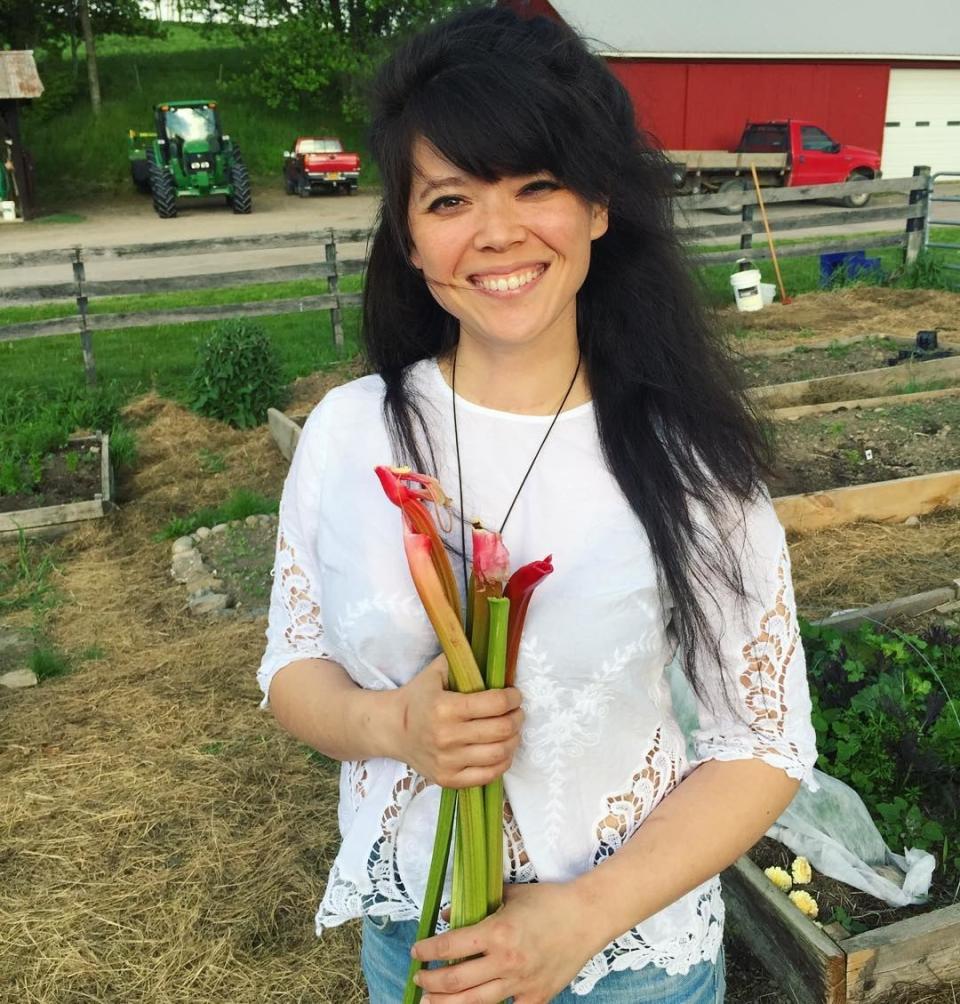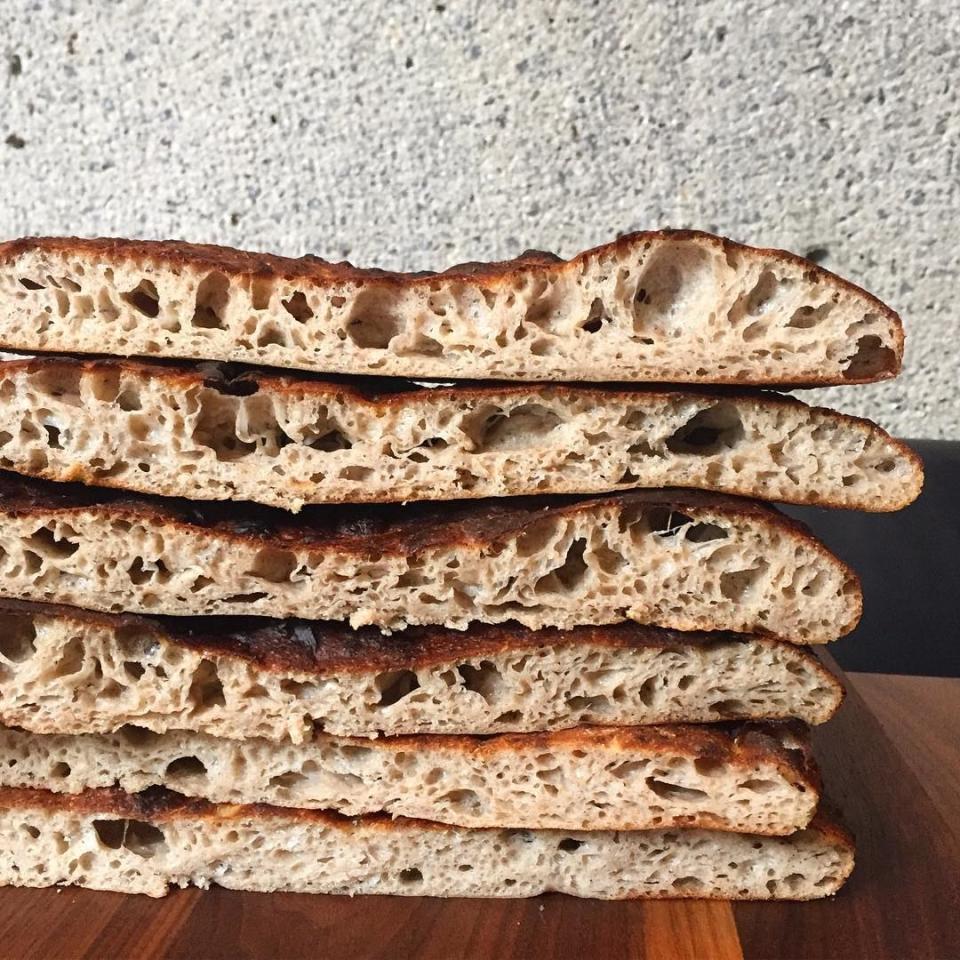A Healthy Sourdough Focaccia Recipe for NYC’s Planned Parenthood Bake Sale
Tomorrow, when New York’s Café Altro Paradiso sets up its second annual bake sale, it will have all the charm of a small-town affair: the daintily dressed tables, the home-style sweets, the neighborhood cause. “But then it’s elevated with this roster of insane talent from across the city,” says pastry chef Natasha Pickowicz, who is spearheading the fundraiser for Planned Parenthood.
For Pickowicz, whose own takes on classics—including the black cardamom sticky buns at Flora Coffee, the fine-tuned layer cakes at last summer’s Wifey pop-up, or Altro’s sourdough focaccia, the recipe for which she shares below—put her squarely in that roster, the fact that the bake sale knits together ideas about food, women’s health, and wellness isn’t an odd mix. “These things are all related!” she says, recalling the conversations that the team at Matter House (the restaurant group comprising Altro, Flora, and Estela) had early last year in the wake of the election. As big-ticketed benefit dinners sprang up in the fine-dining world, she envisioned something more approachable—sidewalk-level, as the case is at Altro’s bake sale. Here, $5 raffle tickets can be traded for sweets and breads from restaurants like Atla, King, Le Coucou, and Otway (to name just a few); cookbook star Alison Roman is bringing along her warning-label-addictive chocolate chunk shortbread cookies.

Stoking a sense of camaraderie among chefs typically tethered to their basement kitchens is part of the mission, but community is at the heart of the fundraiser for PPNYC. “The Planned Parenthood is down the street on Broome, a 10-minute walk from Altro,” Pickowicz says, adding that she’s visited a clinic in the Bronx and another in Brooklyn. “It’s part of my narrative, and I wanted people to feel like donations were doing to directly impact programs in their neighborhoods.” A year and a half into an administration working to erode access to birth control and curtail funding, this value of edible activism only carries more weight. (If you can score a Fanny Gentle–illustrated tote bag, filled with one-off treats like Simone Shubuck ceramics and spice blends from La Boîte, all the better.)
Playing community organizer has been just a part of Pickowicz’s finely calibrated work-life balance these days. In the kitchens at Altro and Flora, she’s busy exploring every facet of rhubarb in advance of the spring harvests. “I made a jelly, I made a compote; I made a sorbet, a granita, an ice cream. I dehydrated it, I candied it. I made a juice, and then we’re tasting it raw,” she rattles off. “It’s pretty athletic, the way that we get into an ingredient. That’s where the answers are revealed to you.” If by day her palate gets put through the flour-sugar-fat ringer, by night she leans toward crunchy vegetables and bright vinegars—simple, clean cravings shaped by her Chinese mother while growing up in Southern California. Now based in Greenpoint, she’s carved out a sort of monastic existence for herself, at least by today’s ever-wired standards. “Not having a TV or a computer or Internet, it makes space for literally everything else in my life that really matters to me, which is cooking and books and music and art, my boyfriend, friends, plants,” she says, allowing that she catches up on The Simpsons by phone on days off. “For me, this is a way of staying a little bit more present.”
Another mode of mindfulness: her sourdough focaccia. The levain (or starter) needs tending to keep it alive, and there’s a learning curve, sure. But the rewards of trial-and-error baking with fermented dough go beyond rich, nuanced flavor. “More than ever, there’s an awareness and appreciation for naturally leavened breads and whole-grain flours,” she says, calling out the additives and preservatives in commercial bread as the real culprit for gluten’s bad rap. Her preferred method of slow, cold fermentation (made popular by bakers like Tartine’s Chad Robertson, she points out) promotes healthy bacteria that aids digestion. And her focaccia recipe, with no stand mixer or loaf-shaping skills required, is a worthwhile starting point. (Pair it with absolutely everything: spring greens, soups, runny eggs, and—why not—rhubarb). Give it a go—or buy it at the bake sale tomorrow.

Sourdough Focaccia
Yield: One sheet tray of bread
625g whole-wheat bread flour (King Arthur is a reliable brand that’s available in most grocery and health-food stores)
520g water
80g levain (sourdough starter—pinch a cup from a bread-loving friend or build your own; Tartine Bread, by Chad Robertson, is a good resource)
25g kosher salt
25g olive oil
Mix the dough
In a wide bowl, combine room-temperature water and the liquid levain. The levain should look bubbly, feel buoyant, and taste a little sweet. Depending on the environment you store your levain, it will become “ripe” anywhere between 3 to 10 hours before ready to mix.
With a clean, wet hand, measure and drop the levain into the bowl of water. The levain should float on the surface of the water.
Add the flour to the bowl and mix to combine, at least 10 minutes if mixing by hand. Let rest 30 minutes, then mix in the olive oil and kosher salt until combined, another 10 minutes.
Turn out the mixture onto a clean bench surface. The dough will be loose and liquidy, and sprinkling a little water on the bench will help it from sticking to your work surface.
Fold the dough
This step helps strengthen the gluten, regulate temperature, and push out any carbon dioxide formed during fermentation.
With the tips of your fingers, push the dough out into a rough square shape. Pick up each other the four “corners,” and gently pull away from the dough, stretching it. Pull it back towards the center of the dough and press down to seal. After stretching each of the four corners, flip the dough over (seam side down, smooth side facing up) and gently shape the dough into a smooth ball.
Put dough in an airtight container (like a big Tupperware), and let rest for 30 minutes. Do three more series of folds over the next 90 minutes, resting the dough at room temperature in between.
After the folds are finished, let the dough sit at room temperature for 5 to 6 hours. It will more than double in size.
Put the container into your refrigerator and let rest for at least 48 hours but up to 72 hours.
Bake the focaccia
Gently tug the dough out of the container and onto a bench sprinkled with water. Shape into a ball and let rest, 30 minutes.
Generously oil a sheet tray with olive oil. Place the dough in the center of the sheet tray and gently dimple the dough, pressing it down and stretching it out to fill the surface area of the tray. If the dough begins to snap back, let it rest (at room temperature) for five minutes before attempting to stretch it again.
Preheat the oven to as hot as it will go—most home ovens can hit between 400 and 450 degrees.
When ready to bake, aggressively dimple the surface of the bread, pressing out the bigger gas bubbles. Drizzle more olive oil on top and sprinkle generously with crunchy grey salt.
Bake until bread is deeply golden and fragrant, about 15 to 20 minutes.
Remove immediately from pan and rest on a drying rack. This bread stays fresh and delicious for up to three days, wrapped tightly in plastic and stored at room temperature.



